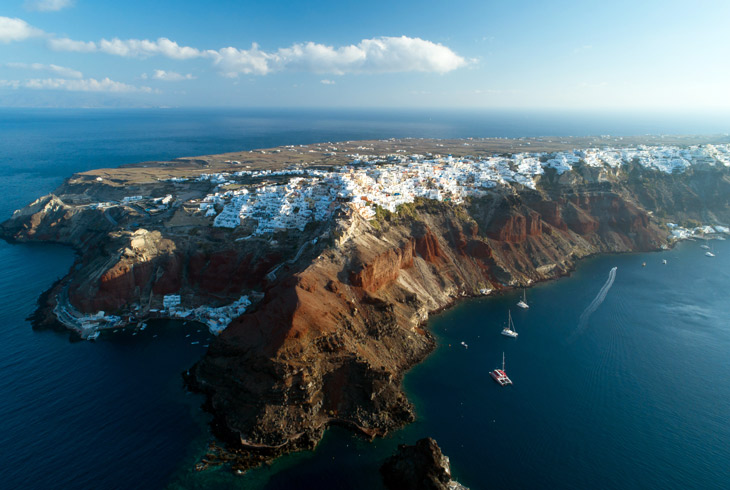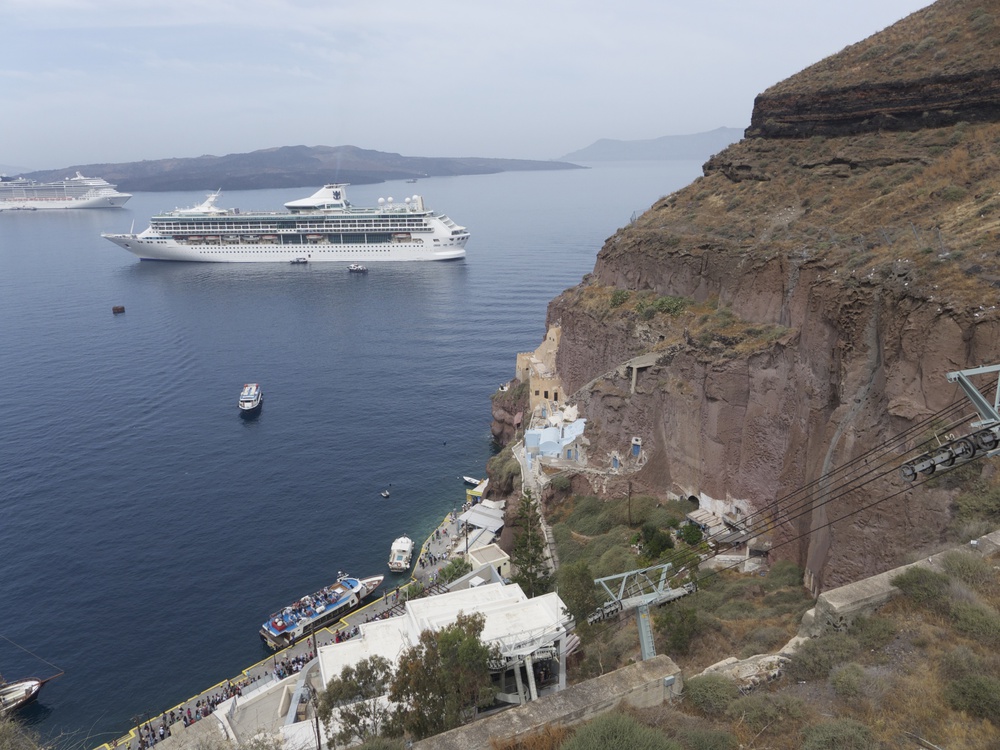
Price: Starting from €420 (indicative price for a group of 10 adults)
Location: Athens, Santorini, Heraklion (Crete)
Duration: four days
This tour will take you to sites such as the village of Oia, with its white houses and famous sunset. The tour includes the archaeological sites of Akrotiri and Knossos, as well as traditional villages such as Megalochori. Enjoy stunning views such as those from Prophet Elias Monastery.
Santorini
One of the most famous Cycladic Islands, Santorini (also known as Thira/Thera) sits roughly halfway between Athens and Crete. About 3,600 years ago, a volcanic eruption caused a part of the island to sink, leaving a caldera with towering cliffs along the east side, thereby creating Santorini’s trademark landscape.
Fira is the island’s capital. It is one of the busiest places on Santorini. Nearby villages are Firostefani and Imerovigli. A path running through these villages is lined with luxurious hotels and restaurant terraces.
Oia is a traditional settlement in the northern part of Santorini. It is also known as ‘Apano Meria’ or ‘Anomeria,’ and its inhabitants are called ‘Apanomerites’. The village is approximately 150 meters (500 feet) above the sea level. Oia was severely damaged in the 1956 earthquake, and much work has been carried out to restore it in a way that brings together functionality, beauty and local taste. Oia is one of the most photographed places in Greece, if not the world. It is best known for its breathtaking sunsets.
Megalochori is one of the most picturesque villages on the island. Its existence is recorded back to the 17th century. Home to historical mansions, old traditional houses and pirate hideaways. Historically, Megalochori’s notables have been the merchants and wealthy estate owners that exported the Vinsanto wine that the island still produces to this day.
Prophet Elias, one of the island’s oldest monasteries, is located on a hill that carries the same name. Mount Prophet Elias lies on the southeast edge of Santorini, 3 kilometers away from the remarkable village of Pyrgos. The monastery, whose exterior stone walls resemble a fortress, was built by two monks in 1711. It soon became an important cultural and educational center that also offered relief to the poor.
Pyrgos village is the highest point on the island of Santorini. Its jaw-dropping panoramic views include the whole island, all the way to the village of Oia. This hillside village was declared a protected settlement in 1995. Pyrgos is a typical fortress-type settlement on the Cycladic Islands. On the hilltop you can find ruins of Kasteli Castle, one of the five ‘kastelia’ on the island. Although there are many reports that Pyrgos was the capital of Santorini in the mid-18th century, in fact that has never been the case. To be fair, we can’t blame anyone for believing that, considering the beauty and strategic position of the village.The Bronze Age settlement of Akrotiri was one of the most important Minoan urban centres and ports in the Aegean Sea, until it was covered by volcanic ash in the 17th century BC. In prehistorical times Akrotiri was a well-connected Minoan port town, a necessary stop along the routes linking mainland Greece with places as far afield as Egypt and Syria. Since the town was covered in volcanic ash until quite recently, the preservation of the settlement is exceptional. This is one of Greece’s most significant archaeological sites, a true jewel of human civilization.
Knossos – Archeological Museum of Heraklion
With more than 1,000 rooms, Knossos was an enormous complex including royal lodgings, spaces for religious worship, shops and warehouses. It was built at the apex of Minoan civilization, one of Europe’s oldest, as it started around 5,500 years ago. As visitors wander through the labyrinthine ruins, they see the original throne of King Minos, the mystifying sanctuaries, the luxurious domestic quarters of the royal family, the pantries that once bursted with Crete’s treasures, and an ancient technological innovation: water-management systems.
The Heraklion Archaeological Museum is one of the oldest and most important museums in Greece. It houses representative artifacts from all periods of Cretan prehistory and history, covering a chronological span of over 5,500 years from the Neolithic period to Roman times. Also, visitors can find a unique Minoan collection, which includes unique masterpieces of Minoan art.
Day 1
5:45 am Depart from Athens (Hotel)
7:25 am Take the ferry from Piraeus port to Santorini
2:50 pm Arrive at Santorini port
3:30 pm Check in at your hotel
4:30 pm Start the bus tour
8:30 pm Return at the hotel
Day 2
7:30 – 8:30 am Breakfast
9:00 am Start of the bus tour
1:00 pm End of the bus tour
1:00 – 5:00 pm Free time – Lunch
5:00 pm Transfer to Oia
5:30 – 8:00 pm Tour to Oia by foot, take photos of sunset
8:30 pm Return at the hotel
Day 3
8:00 – 9:30 am Breakfast
10:30 am Check out from hotel
11:00 am Start bus tour
4:00 pm Take the ferry from Santorini’s port to Heraklion
5:45 pm Arrive at Heraklion
6:30 pm Check in at your hotel
7:00 pm Free time
Day 4
7:00 – 8:00 am Breakfast
8:00 am – 4:00 pm Bus tour including visit to Knossos and Archaeological Museum
4:00 pm Transfer to Heraklion airport
8:00 pm Arrive at Athens hotel
Departure Point: Either your hotel in Athens, or meeting point at Plateia Eleftherias 23, Athens 10553.
Departure Time: This is a private tour. Only your group will participate. The pick-up times is adjustable upon your request.
Return Details: Returns to original departure point.
Price includes:
Price does not include:




If you are planning a tour in Greece we will be happy to help you.
We accept the following payment methods and bank transfer:




Plateia Eleutherias 2
Athens, Greece, 10553
+3021 55 01 89 99
WeChat1: zy2262144310
WeChat2: zh786425788
travel@greekpanda.com
facebook/GreekPandaTravel
GNTO licence 0206E600005433
Member of HATTA
Copyright © 2016-2024. All rights reserved by Greekpanda Travel.